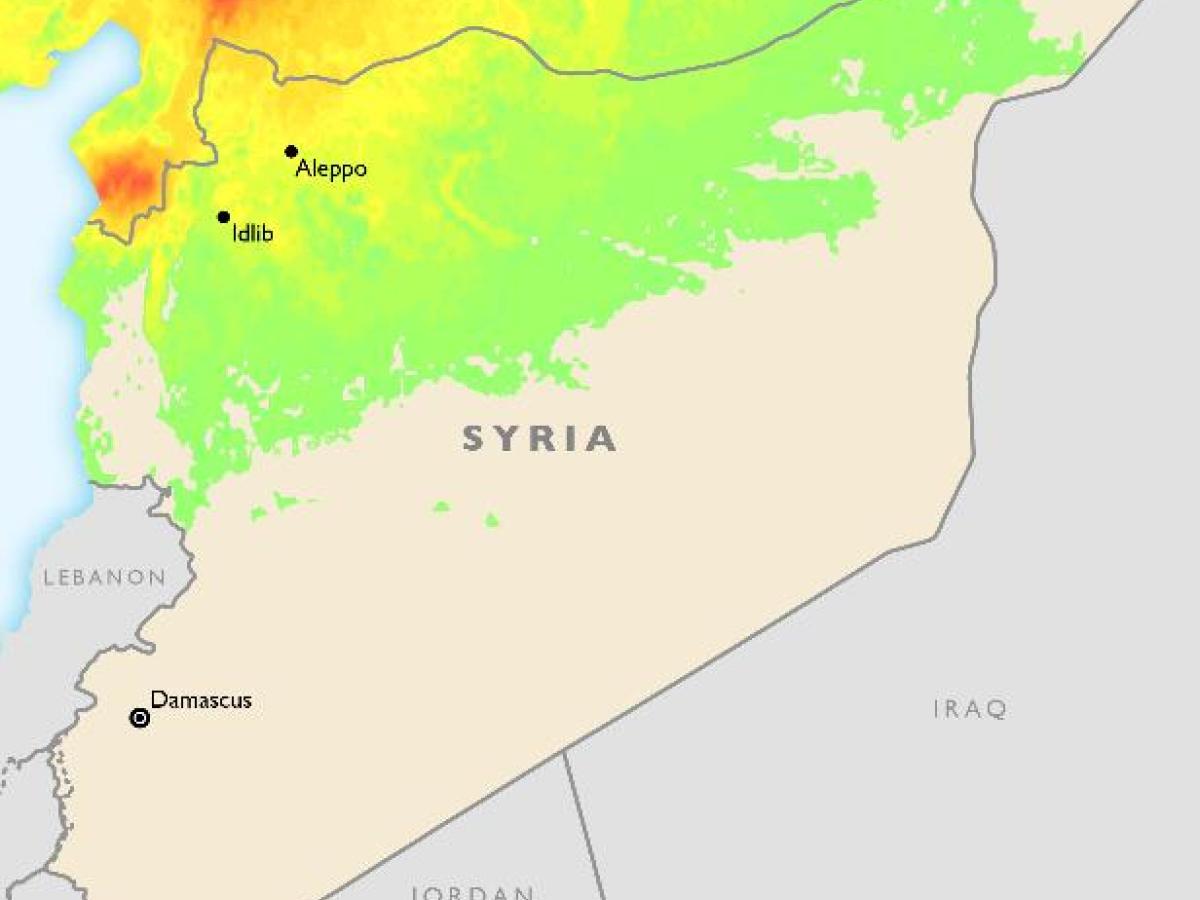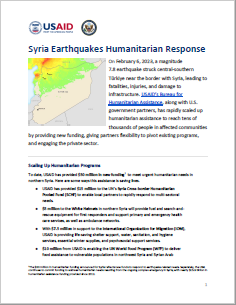On February 6, 2023, a magnitude 7.8 earthquake struck central-southern Türkiye near the border with Syria, leading to fatalities, injuries, and damage to infrastructure. USAID’s Bureau for Humanitarian Assistance, along with U.S. government partners, has rapidly scaled up humanitarian assistance to reach tens of thousands of people in affected communities by providing new funding, giving partners flexibility to pivot existing programs, and engaging the private sector.
Scaling Up Humanitarian Programs
To date, USAID has provided $50 million in new funding1 to meet urgent humanitarian needs in northern Syria. Here are some ways this assistance is saving lives.
- USAID has provided $15 million to the UN’s Syria Cross-border Humanitarian Pooled Fund (SCHF) to enable local partners to rapidly respond to multi-sectoral needs.
- $5 million to the White Helmets in northern Syria will provide fuel and search-and-rescue equipment for first responders and support primary and emergency health care services, as well as ambulance networks.
- With $7.5 million in support to the International Organization for Migration (IOM), USAID is providing life-saving shelter support, water, sanitation, and hygiene services, essential winter supplies, and psychosocial support services.
- $10 million from USAID is enabling the UN World Food Program (WFP) to deliver food assistance to vulnerable populations in northwest Syria and Syrian Arab Republic Government-held areas. The UN organization has reached more than 156,200 people with hot meals and ready-to-eat rations and hot meals and 480,000 people in northwestern Syria with regular food rations and cash transfers.
- USAID is allocating $12.5 million to other UN and non-governmental organization (NGO) partners to provide emergency assistance including health, protection, food, water, sanitation, hygiene, and multi-purpose cash assistance to earthquake-affected communities.
Adapting Existing Programs
After the earthquake, USAID and U.S. Department of State Bureau of Population, Refugees, and Migration (State/PRM) partners immediately adapted existing humanitarian programs to meet changing needs and mobilized personnel to conduct rapid needs assessments. The United States is the largest donor of humanitarian assistance to the people of Syria, providing nearly $16 billion in humanitarian aid since 2012.
Water, Sanitation, and Hygiene
- The UN Children’s Fund (UNICEF) is conducting rapid assessments of water, sanitation, and hygiene needs at temporary shelters and is providing water trucking to an estimated 60,000 people in Aleppo, Hamah, Tartus and Latakia. The UN agency also immediately deployed mobile health and nutrition teams to Aleppo, Hamah, Latakia, Idlib and Tartus.
- A USAID NGO partner is delivering water to nearly 100 camps for internally displaced persons and testing water quality at 45 camps to help ensure people don’t get sick from waterborne illnesses.
Health
- A USAID NGO partner is responding to emergency medical needs in northwest Syria by supporting nine hospitals, providing psychological first aid, and supplying local health facilities with medical commodities.
- With support from USAID, an international NGO partner has deployed mobile medical units to provide primary health, trauma, and sexual and reproductive health services. The partner has also delivered medicines, medical supplies, and cholera kits to Aleppo.
- USAID is supporting the operation of six mobile clinics that serve displaced people living in collective shelters in northwest Syria.
- A State/PRM partner is providing critical medical supplies to hospitals in Syria’s earthquake-affected areas.
Relief Commodities & Other Aid
- A USAID partner is removing rubble and providing relief commodity kits, kitchen sets, and hygiene items to thousands of newly displaced families.
- USAID is providing fuel and heaters to people living in shared emergency shelters in Syria, as well as thousands of liters of fuel to Syrian medical facilities in partnership with an international NGO. We are also supporting search-and-rescue teams, medical consultations and treatments for tens of thousands of people, and ready-to-eat meals for thousands of individuals.
- USAID is also supporting an NGO partner providing cash assistance thousands of families in Afrin and Azaz are using to purchase food and other essential items.
- A State/PRM partner is providing relief commodities to families throughout northern Syria. To date, the partner has released more than 30,000 relief commodity kits and supported more than 30,000 families with winter clothing.
U.S. Policy Supporting Aid to Syria
- U.S. Ambassador to the UN Linda Thomas-Greenfield has underscored the importance of expanded humanitarian access into northwest Syria, including through authorization of additional cross-border entry for use by the UN and its implementing partners.
- On February 9, the U.S. Department of the Treasury’s Office of Foreign Assets Control (OFAC) issued a temporary general license for a period of 180 days to expand authorizations under the Syrian Sanctions Regulations to support emergency earthquake relief efforts in Syria.
Private Sector Activities Supported by USAID
- Days after the earthquakes, USAID joined the U.S. Chamber of Commerce to coordinate donations from global businesses. By February 22, global businesses had donated $86 million, with a significant portion designated for Syria.
- With USAID support, the Humanitarian Grand Challenge Hope in Conflict accelerator has supported the development of more than a dozen innovations specific to Syria, with several now contributing to the earthquake response. One innovator, Needslist.co, is matching donations from registered offerers with humanitarian responders who need specific items and services.
1 The $50 million in humanitarian funding announced for Syria reflects new funds to respond to earthquake-related needs. Separately, the USG continues to commit funding to address humanitarian needs resulting from the ongoing complex emergency in Syria, with nearly $15.9 billion in humanitarian assistance funding provided since 2012.


